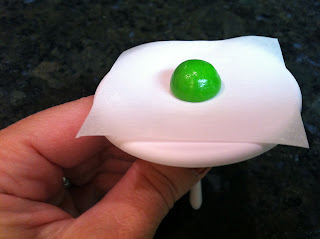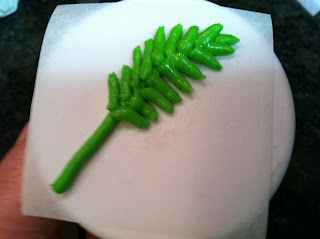The Rhode Island Greening Apple was developed in its home state (where it is, probably obviously, the official fruit) around 1796! It's a very round, yellowish-green apple, and is known for retaining its sharp taste in cooking. I haven't quite mastered the art of piping a perfect ball-shaped figure that retains its shape, but this little hemisphere would make a fine topper for any apple dessert (cupcakes, muffins, whatever). All you'll need is stiff consistency royal icing in yellowish-green and brown, round tips #12 and #4, a flower nail, a Styrofoam brick to rest the nail in, a glue stick, parchment paper squares, and a dusting pouch filled with a 50/50 mix of powdered sugar and cornstarch. Start by sticking a parchment square to the flower nail with a dab from the glue stick.
Attach the #12 tip to the bag of green icing. Hold it at a 90 degree angle to and just above the surface, and squeeze steadily while moving the tip straight upward for about an inch. Stop pressure and pull the tip away.Liberally dust your fingertips by touching them to the dusting pouch, and tap the icing into this half-sphere shape.
Finally, press the end of the #4 tip about a millimeter into the center at a right angle, and squeeze out a very short stem with the brown icing. Stop pressure and pull the tip away, adjusting the stem with a dusted fingertip if need be.




















































